Tomatoes are one of the most popular vegetables grown in the home garden and are also one of the most attacked by insect and animal pests alike. So if you grow organic vegetables in your garden and you start seeing holes in your tomatoes, it can be pretty upsetting, especially since you have spent a lot of money to grow these plants. Let’s find out, what is eating holes in my tomatoes.
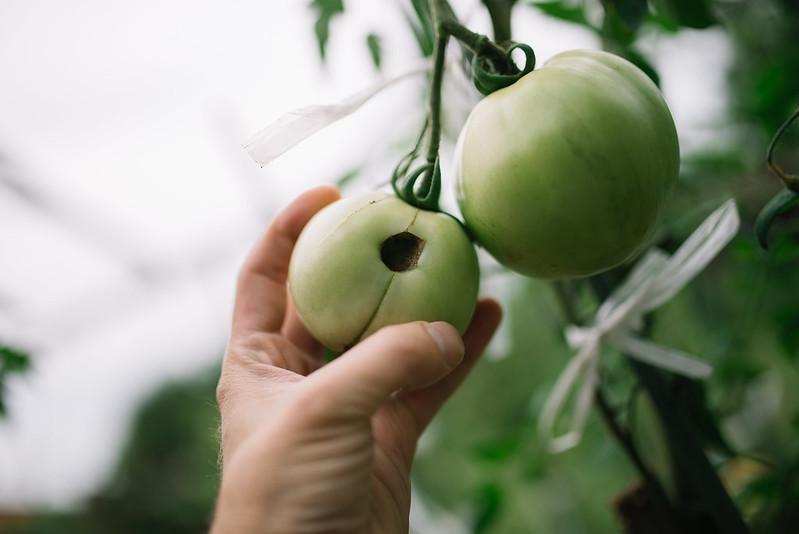
A hole in an unripe green tomato.
Tomatoes are one of the most popular vegetables grown in the home garden and are also one of the most attacked by insect and animal pests alike. So if you grow organic vegetables in your garden and you start seeing holes in your tomatoes, it can be pretty upsetting, especially since you have spent a lot of money to grow these plants.
Many gardeners have this problem, and there are a few different animals that could be causing it. So, let’s go ahead and learn about the insects and animals that cause holes in tomatoes, so you can narrow down the culprit and take steps to prevent it in the future.
Insects such as fruitworms, hornworms, flea beetles, and stink bugs are usually the major causes of holes in your tomato plants and fruits. Larger garden pests such as slugs, snails, and rodents also make holes in tomatoes but usually damage the entire plant and foliage more than the fruit itself.
Tomato Fruitworms
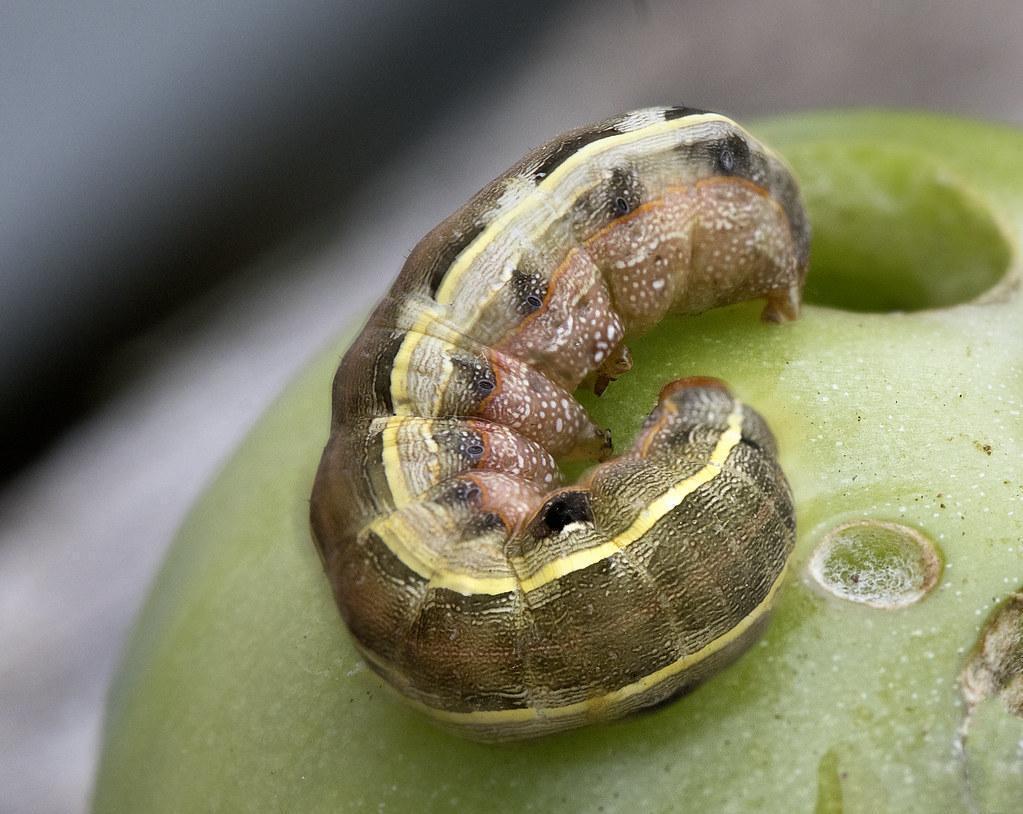
Tomato fruitworms, aka cotton bollworms, are insects that attack tomatoes and other plants.
Tomato fruitworms are larvae from a moth species that feed on tomatoes and other similar plants. They are the pests responsible for the spread of most common tomato diseases and can cause considerable damage to your garden’s yield if not controlled on time.
If you notice any unusual holes in your tomatoes, you should investigate further as it could be the work of this moth species. Tomato fruitworm larvae reproduce and lay eggs with wet, sugary, fertilized pod-like structures which look like worms.
The tomato worm isn’t very aggressive; however, if you don’t remove them from your plants soon enough, they might turn into adults and eat your whole tomato crop!
RELATED: Vegetable Tomato Leaf Curl Virus: What Are the Causes & How to Fix Them?
Control
Pesticides are one of the most effective ways to control this moth pest. They are applied to plants at a rate that will kill all larvae. To get the best results, you should use the pesticide before the fruitworms hatch to prevent them from infesting the plant.
Tomato Hornworms

Tomato hornworms are very large caterpillars with horn-like tails.
If you see two or three holes at random spots on your tomato plant, you may have a hornworm infestation going on! Hornworms are a common pest in the tomato patch.
They are fuzzy and small caterpillars that can be up to 1 inch long with three pairs of black horns on their heads. These pests can cause significant damage to your tomato plants if they are not controlled soon after they hatch.
These pests like to make nests inside plants near their roots (especially when they’re small).
Once they finish eating fruits in one spot, they’ll start munching away at the leaves from that area rather than moving around and searching for more plants to eat.
Control
Hornworms can be controlled by handpicking them one at a time or using pyrethrin-based sprays that target hornworms specifically. If you’re worried about pesticides harming beneficial insects or pollinating plants nearby, consider using an organic pesticide instead.
Snails & Slugs
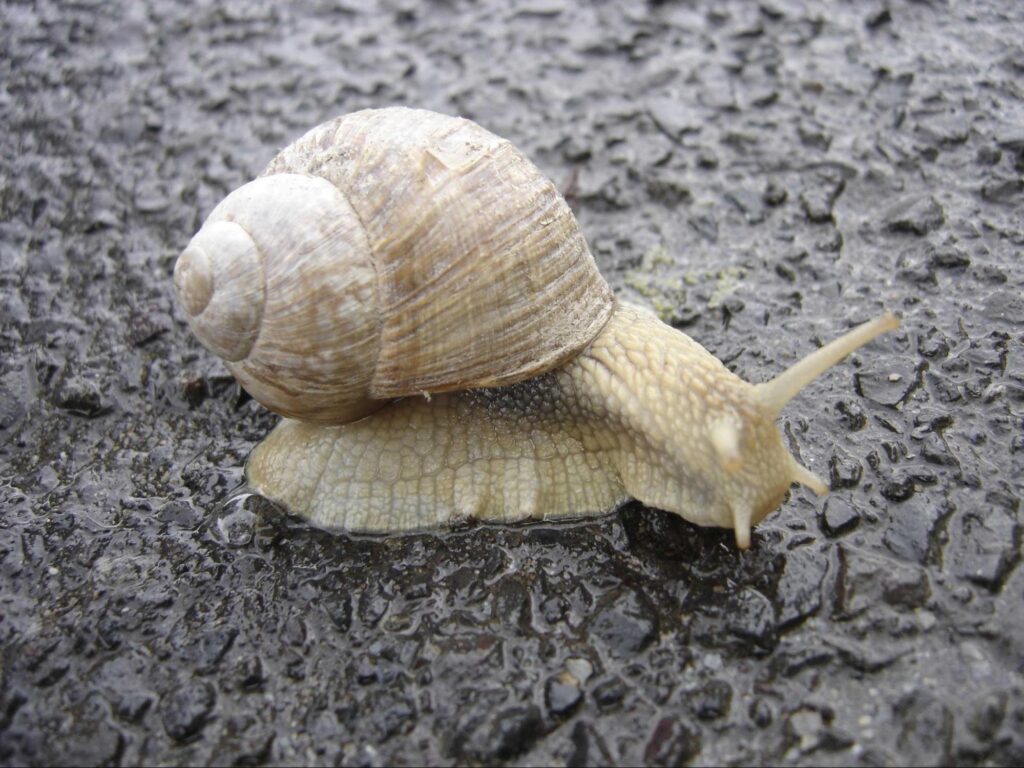
Unfortunately, both slugs and snails will eat your tomato plants.
If you notice holes in your tomatoes, it may also be due to snails or slugs making their way inside the plant. Snails and slugs are the most common garden pests in some tomato fields. They can be particularly troublesome for tomato plants grown from seed.
A slime causes snail and slug tomato holes. This slime is a mixture of saliva, mucus, and digestive enzymes that dissolve the tomatoes’ cell walls, letting the snail or slug eat through them. This slime also protects the slug or snail from being eaten by other animals.
Control
The best way to control snails and slugs eating holes in tomatoes is by using copper tape. Copper tape is a standard gardener product, and it can be purchased from most garden stores. The Copper tape is placed around the stem of the tomato plant, just above the soil line.
This tape should be tied around the stem with twine or wire and then buried deep enough into the soil so that the copper will not touch the tomato leaves or fruit.
Flea Beetles

Flea beetles are common pests of seedling tomatoes in most areas.
The Flea Beetle is a common household pest that can cause severe damage to your tomato plants, fruits, and flowers. This tiny, soft-bodied insect lays its eggs in the papery covering of the tomato plant. The larvae develop from the eggs and then feed on the developing fruit and skeleton of the tomato plant. Flea beetles can attack tomato leaves, but usually, they do not leave any marks on the fruit.
Control
To prevent this problem from occurring in your garden, you must identify the source of these insects and take action to remove them. For instance, you can remove all your plants from areas where flea beetles are known to live.
It will also help if you keep mulch around your plants so that any eggs laid by the flea beetles can’t survive long enough to develop into adult fleas.
Cutworms
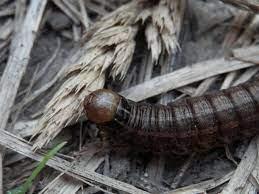
Cutworms attack many field crops and vegetables such as asparagus, bean & tomatoes.
Cutworms or Tomato loopers can also be responsible for the holes in your tomatoes. Cutworms are a common problem in many gardens. Cutworms are not technically insects but the larvae of moths. They bore into the stems of plants and eat them from the inside out. Cutworms can be found on all types of tomato plants, but they’re most likely to attack young seedlings. This is because they like to eat plants that are growing rapidly, so they’ll attack anything they see as a potential meal.
Control
The most effective way to control cutworms is by handpicking them off your tomato plants. You can also use an insecticidal soap spray or neem oil on your plants to deter cutworm activity.
If you’ve already had an infestation of these bugs, you may want to consider using a non-chemical solution such as garlic oil or pyrethrin dust, which will give you longer-lasting results than insecticidal soap sprays and neem oil.
Stink Bugs
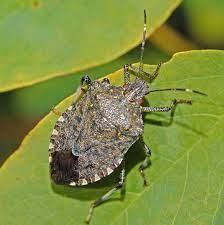
Stink bugs have long mouthparts to pierce tomato leaves, stems, and fruit.
Stink bugs are bugs with an unpleasant odor and a powerful sting. They get their name from the smell they emit when they are disturbed. Stink bugs don’t eat the leaves of tomato plants, they only eat the fruit, and they do it by making holes in the fruit that stink a lot.
The holes are small at first, but as they get bigger, they start to make the fruit look like an apple corer. Once the stink bug starts eating through the skin of the tomato, it’s almost impossible to stop them from destroying it.
Control
Stink bugs love to eat holes in healthy plants, so you should be on the lookout for them and get rid of them as soon as possible. The best way to do this is by using a suitable insecticide or horticultural oil to keep the bugs away.
Another way to get rid of these bugs is by using beneficial insects such as ladybugs or wasps. These insects will eat up the stink bugs when they come close to your plants.
Aphids
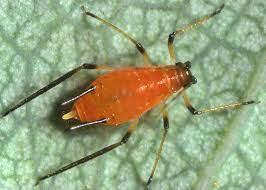
Severe aphid infestations can cause leaves to curl and may stunt plants.
Aphids are small, soft-bodied insects that suck the juices from plants. They often appear on tomato leaves and stems, causing them to curl and distort. These aphids are usually green or yellowish, although some species have black spots or stripes.
In some cases, aphids can remove the leaves of tomatoes, causing holes in the fruit. These holes are not a direct result of feeding; instead, they are caused by the aphids that have sucked out the juice from a leaf, leaving behind a hollowed-out area.
Control
The best way to get rid of aphids on tomatoes is to spray them with insecticidal soap (which contains neem oil) or water. You can also spray your tomato plants with diluted white vinegar every few days until the problem disappears.
Aphids can also be controlled through biological control. However, If there is not enough natural predation by beneficial insects, you will need to apply an insecticide.
Frequently Asked Questions
What animal eats tomatoes at night?
Skunks, rats, raccoons, and deer are among the nocturnal feeders that love tomato plants. Rats and raccoons will eat more of the lower-hanging fruits. Skunks are the least destructive since they only eat one piece of low-hanging fruit.
What kills tomato fruit worms?
Sprays of the bacterium Bacillus thuringiensis can be used to control armyworms, hornworms, and tomato fruitworms. Caterpillars are the only insects this naturally occurring bacteria can kill.
What does a tomato fruit worm look like?
When tomato fruitworm larvae hatch, they are creamy white caterpillars with prominent black heads and black hairs. On the hand, the color of larger larvae is yellowish green to almost black, and they also grow small white lines throughout their bodies while keeping the black spots at the base of their bristle-like hairs.
What is the best insect spray for tomato plants?
Insecticidal soap or neem oil extract for controlling aphids and whiteflies, Bacillus thuringiensis (Bt) or pyrethrum for controlling beetles, and horticultural oil for controlling stink bugs are some examples of effective organic insect sprays for the tomato plants.
Sources For Further Reading
What’s Causing the Tiny Holes on My Tomato Leaves?. (2022). Retrieved 20 July 2022, from https://extension.sdstate.edu/whats-causing-tiny-holes-my-tomato-leaves
Trouble(s) with Tomatoes. (2020). Retrieved 20 July 2022, from https://extension.illinois.edu/blogs/good-growing/2020-05-01-troubles-tomatoes
Tomato Fruit Problems. Retrieved 20 July 2022, from https://www.missouribotanicalgarden.org/gardens-gardening/your-garden/help-for-the-home-gardener/advice-tips-resources/visual-guides/tomato-fruit-problems.aspx
Editor’s Recommendations
Pests in Succulents How to Get Rid of Them for Good!
What Smells Keep Roaches Away? Learn All About It for Good!
What Insects Does Cinnamon Repel Plus How to Use it to Keep Them Away?







